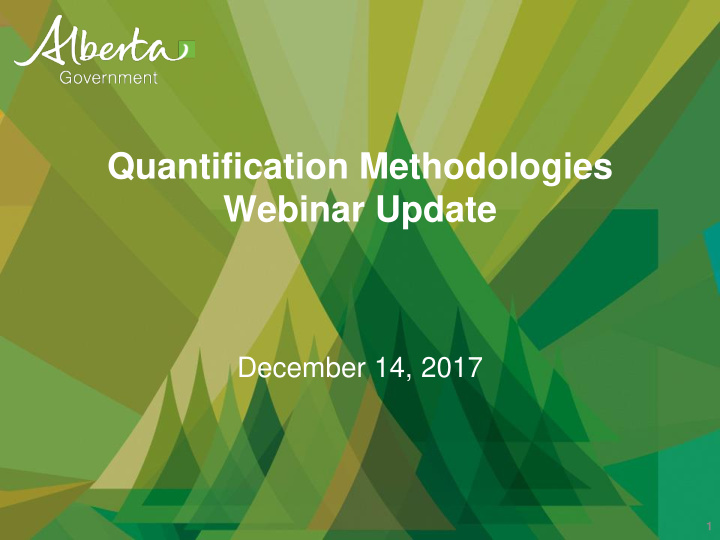



Quantification Methodologies Webinar Update December 14, 2017 1
Overview • Webinar Logistics • Introduction • Overview of Regulatory System • Alignments with Federal and Other Requirements • Application of Quantification Methodologies • Reporting Structure • Quantification Methodology Developments • Deviation Requests 2
Introduction 3
Introduction • ACCO developing standardized quantification methodologies to be used under the Carbon Competitiveness Inventive Regulation (CCIR) and Specified Gas Reporting Regulation (SGRR) • CCME work on standardizing quantification methodologies • Common benchmarks will be used across facilities regulated under CCIR • Lowered reporting threshold for facilities under SGRR 4
Regulatory Overview 5
Carbon Competitiveness Incentive Regulation (CCIR) • On December 6, 2017 ACCO announced policy forming the CCIR. • Webinar outlining key policy decisions was delivered to regulated facilities along with sector specific breakout sessions. • Please see information located here: https://www.alberta.ca/cci • Slides will be made available. 6
Specified Gas Reporting Regulation (SGRR) • Alberta’s mandatory GHG reporting program • Builds on voluntary reporting by most Alberta emitters since mid-1990s • Regulation and Standard passed in 2003 – Regulation amendments accompany CCIR – Draft Standard posted to website for comment • aep.alberta.ca/climate-change/guidelines- legislation/specified-gas-reporting- regulation/default.aspx • Comments will be accepted until January 15, 2018 • Continue to work with the ECCC national “one - window” reporting system 8
2017 SGRR Standard Key Updates 1. Emission threshold for reporting 2. Definition of direct and threshold emissions 3. Additional Specified Gases Global Warming Potentials (GWPs) 4. References for quantification methodologies 9
Structure of Methodology Documents 10
Structure of Methodology Documents • Quantification methodologies will be tiered (Tier 1, 2, 3 or 4) by source category to cover both regulations. • Source categories are shared between regulations, but different tiers will apply. • Program and tier requirements are provided in the Specified Gas Reporting Standard and Standard for Completing Greenhouse Gas Compliance and Forecasting Reports.
Alignment with Federal and Other Requirements 12
Key Points • Working to ensure that ECCC requirements are met under SGRR • Intend to be aligned with AER reporting and quantification methodologies on methane related rules as they are developed • Streamlined reporting for industry 13
Application of Quantification Methodologies 14
SGRR 2017 Mandatory Requirements • Align with ECCC increased reporting requirements for the five Phase 1 sectors • All facilities emitting 10 kt or above must report emissions, in alignment with ECCC requirements 15
SGRR 2018 Mandatory Requirements • Align with ECCC increased reporting requirements for the five Phase 1 sectors plus any others if and when implemented • Apply quantification methodologies made mandatory under CCIR, using tiers appropriate for reporting facilities • All facilities emitting 10 kt or above must report emissions 16
CCIR 2018 Mandatory Requirements • Ensure consistency in quantification methodologies used for regulated facilities as we transition to common benchmarks. • First set of mandatory chapters anticipated to cover the majority of emissions generated by regulated facilities. • Categories that will be mandatory for 2018: • Stationary fuel combustion • Industrial process emissions • Production of products with established benchmarks • Imports (electricity, heat and hydrogen) 17
CCIR 2018 Mandatory Reporting • Intend to phase in other mandatory chapters for 2019 and subsequent years. • Will engage on 2019 requirements fall of 2018. 18
Quantification Methodology Development 19
Quantification Method Chapters • Chapter 1: Stationary Fuel Combustion • Chapter 2: Flaring • Chapter 3: Fugitives • Chapter 4: Venting • Chapter 5: On-Site Transportation • Chapter 6: Waste and Wastewater • Chapter 7: Biomass Combustion and Decomposition • Chapter 8: Industrial Processes • Chapter 9: HFCs, PFCs, SF6s • Chapter 10: Formation CO2 • Chapter 11: Injected, Send Off, Received On CO2 • Chapter 12: Imports • Chapter 13: Production • Chapter 17: Measuring, Sampling, Analysis and Data Management • Chapter 20: Tier Specification • Chapter 14, 15, 16, 18, 19 currently placeholders if additional categories needed. 20
Development • Chapter 1 Stationary Fuel Combustion has been posted for comment: http://aep.alberta.ca/climate-change/guidelines-legislation/specified-gas- reporting-regulation/default.aspx • Next group of chapters to cover other mandatory source categories (Industrial Process, Production, Imports) will be posted for comment in January 2018. • Chapters on venting, flaring, on-site transportation (OST), fugitive, waste and waste water, and formation CO 2 are being developed and will be posted for comment in early 2018. – Once comments are received and reviewed a published version will be posted. • Refinements and additional chapters including HFCs/PFCs, CO 2 import and exports, and biomass decomposition are anticipated in Fall 2018 for 2019 use . 21
Deviation Requests 22
Deviation Requests • Where mandatory elements cannot be implemented, facilities under the CCIR may request a deviation. • Request for deviations are subject to review and approval of the Director. 23
Questions 24
Recommend
More recommend